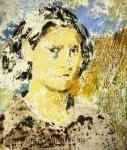Joan Kathleen Harding Eardley
Joan Kathleen Harding Eardley
Place: Warnham
Born: 1921
Death: 1963
Biography:
Joan Kathleen Harding Eardley was a British artist noted for her portraiture of street children in Glasgow and for her landscapes of the fishing village of Catterline and surroundings on the North-East coast of Scotland. One of Scotland's most enduringly popular artists, her career was cut short by breast cancer. Her artistic career had three distinct phases. The first was from 1940 when she enrolled at the Glasgow School of Art through to 1949 when she had a successful exhibition of paintings created while travelling in Italy. From 1950 to 1957, Eardley's work focused on the city of Glasgow and in particular the slum area of Townhead. In the late 1950s, while still living in Glasgow, she spent much time in Catterline before moving there permanently in 1961. During the last years of her life, seascapes and landscapes painted in and around Catterline dominated her output.
Joan Eardley was born at Bailing Hill Farm in Warnham, Sussex, where her parents were dairy farmers. Her mother, Irene Helen Morrison, (1891-1991), was Scottish and had met Captain William Edwin Eardley, (1887-1929), during World War One when he was stationed in Glasgow. Later in the war he fought in the trenches on the Western Front, was wounded in a gas attack and suffered shell-shock. The couple married at the end of the war, but Captain Eardley experienced episodes of depression and suffered a mental breakdown during Joan's early childhood. . After the failure, and subsequent sale, of his farm in 1926, Captain Eardley worked for the Ministry of Agriculture and Joan's mother took her and her younger sister, Pat, (1922-2013), to live with her own mother in Blackheath, London. In 1929 an aunt paid for Joan and Pat's education at a private school, St Helen's School, where Joan's artistic talent was first recognised. In 1929 Captain Eardley committed suicide, although the details of his death were not explained to Joan and Pat until years later.
Eardley trained at the local art school in Blackheath for two terms, and in 1938 enrolled at Goldsmiths College which she attended for one term. In 1939 Eardley, her mother and her sister moved to Glasgow to live with her mother's relatives in Bearsden, after a short period with other relatives Auchterarder.
In January 1940 Eardley enrolled at the Glasgow School of Art as a day student where she studied under Hugh Adam Crawford and was influenced by the Scottish Colourists. She met painter Margot Sandeman, who became a close, and lifelong, friend. Sandeman and Eardley would often paint together and also shared family holidays and camping trips. In 1941, they acquired a horse and caravan and travelled around Loch Lomond to paint and sketch. For many years, they also visited Corrie on the Isle of Arran, using an outhouse, "The Tabarnacle", as a studio.
By 1942, Eardley had completed the School of Art's General Course and began the diploma course in drawing and painting. The next year Eardley was awarded the diploma in drawing and painting. Her diploma painting, a self-portrait, was her only excursion into formal portraiture and she was awarded the school's Sir James Guthrie Prize for it. Her biographer Christopher Andreae notes it as nevertheless remarkably informal picture, a precursor to the charcoal studies she made in Italy and these in turn a preparation for her many drawing, pastels and paintings of Glasgow street children. :117 The prize, a biography of Guthrie by Sir James L. Caw and published by Macmillan & Co. of London in 1932, is still in the possession of Eardley's family.
After graduating in 1943 Eardley trained as a teacher at Jordanhill Teacher Training College, but she never liked classroom teaching and left after one term. She chose instead to work as a joiners apprentice with a small boat building firm in Bearsden. This work, which, throughout 1944 included painting camouflage patterns on landing craft for the war effort, allowed Eardley to attend evening classes at the Glasgow School of Art until 1946. During the war, her painting of her shipyard work mates, The Mixer Men was shown at Royal Glasgow Institute of the Fine Arts. Eardley went back to London for a short time, but returned to Scotland to continue her studies in 1947 at Hospitalfield House, in Arbroath under James Cowie, who influenced her choice of everyday subject matter. In 1948 Eardley returned to the Glasgow School of Art to complete a post-diploma course.
In 1948 the Royal Scottish Academy awarded Eardley a Carnegie scholarship which, together with a travelling scholarship from the Glasgow School of Art, allowed her to visit Italy and, briefly, Paris for several months in 1948 and 1949. In September 1948 she travelled by boat and train to Florence. There she saw many works by Italian Renaissance artists and in particular she admired fresco cycles by Giotto, by Masaccio in the Brancacci Chapel and also works by Piero della Francesca. She valued these artists' humanity and the sculptural aspects of their work. She visited churches and monasteries in Assisi before visiting Forte dei Marmi in November 1948. There she painted fishermen working on their nets, a subject she returned to years later in Catterline. Eardley spent Christmas 1948 in Paris before travelling to Venice in January 1949. In Venice she fell ill and had to travel to Florence for treatment by an English speaking doctor. Once recovered, she divided her time between Arezzo, Ravenna as well as Florence and Venice.
More...
Wikipedia link: Click Here














